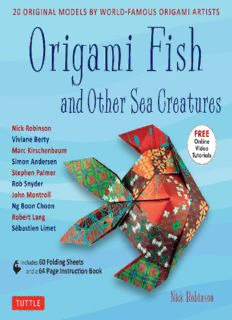
Origami Fish and Other Sea Creatures Ebook: 20 Original Models by World-Famous Origami Artists PDF
Preview Origami Fish and Other Sea Creatures Ebook: 20 Original Models by World-Famous Origami Artists
20 ORIGINAL MODELS BY WORLD-FAMOUS ORIGAMI ARTISTS Origami Fish and Other Sea Creatures Nick Robinson Viviane Berty Marc Kirschenbaum Simon Andersen Stephen Palmer Rob Snyder John Montroll Ng Boon Choon Robert Lang Sébastien Limet Nick Robinson ABOUT TUTTLE: “Books to Span the East and West” Our core mission at Tuttle Publishing is to create books which bring people together one page at a time. Tuttle was founded in 1832 in the small New England town of Rutland, Vermont (USA). Our fundamental values remain as strong today as they were then—to publish best-in-class books informing the English-speaking world about the countries and peoples of Asia. The world has become a smaller place today and Asia’s economic, cultural and political influence has expanded, yet the need for meaningful dialogue and information about this diverse region has never been greater. Since 1948, Tuttle has been a leader in publishing books on the cultures, arts, cuisines, languages and literatures of Asia. Our authors and photographers have won numerous awards and Tuttle has published thousands of books on subjects ranging from martial arts to paper crafts. We welcome you to explore the wealth of information available on Asia at www.tuttlepublishing.com. CONTENTS Introduction Origami Techniques Folding Thirds Fish Silhouette Simple Fish Multiform Fish Pureland Fish Bubblefish 3D Fish Goldfish Telescope Goldfish Angel Fish Flatfish Clownfish Carp Swimming Fish Moray Eel Banded Angelfish Fish Bones Shark Manta Ray Koi Carp Puffer Fish Levels of Difficulty Easy Medium Challenging Difficult How to Download the Folding Demonstration Videos for this Kit 1. You must have an Internet connection. 2. Click the link below or copy paste the URL to your web browser. http://www.tuttlepublishing.com/origami-fish-and-other-sea- creatures-kit-demos For support, email us at [email protected] Make Your Fish Live and Breathe Fish are a vital part of the world we live in—they provide around 5 billion people with food. They are also diverse, with over 28,000 different species. They range in widely different sizes, shapes and colors. Origami has a wide range of different styles; from simple to complex, from realistic to caricature. The fish in this book range from simple to rather difficult, although there are many complex designs out there with well over 100 steps! One of the traditional origami bases is called the “Fish Base,” because it quickly transforms into a fish with a couple of folds. The “Telescope Goldfish” (page 21) starts with this base. However, origami designers have developed a wide range of different approaches to folding a fish, carefully engineering the paper to provide flaps where you need them (for example, the tail fins). Some designs also use the different sides of the paper to create areas of different colors within the model. While many models are essentially flat, some designs presented here allow you to “round” the paper, so it becomes three-dimensional. Some paper is better for this purpose than others; please experiment with your folding material. Try also to select paper with suitable colors and patterns to show your creation to its best effect. You can also try hanging groups of them from threads so they turn in a gentle breeze. The ability to adapt an existing design allows you to make many different variations. Remember, when folding a model, always use your imagination – if you can change a design by altering folds, angles and distances, you should do so and try to create a brand new model. Obviously, you should aim for accuracy when folding, but also try to be sensitive to the paper and to aim for elegance and beauty – make your fish live and breathe. —Nick Robinson
